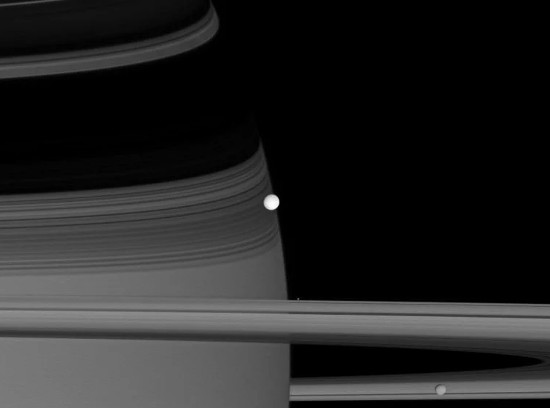Although NASA’s Cassini mission ended in 2017 when the spacecraft plunged into Saturn’s atmosphere, the data collected from its nearly 20-year journey from Earth continues to amaze the scientific world.
When Cassini rendezvoused with Enceladus it discovered venting from the moon’s southern polar region back in 2005. Three subsequent passes happening from 2008 to 2009 confirmed that this wasn’t a one-time event. As the spacecraft flew through the ejected material, the onboard Cosmic Dust Analyzer analyzed the content. The plumes contained fine grains of ice and water vapour. The ice particles hit the spacecraft at speeds of between 6.5 and 17.5 kilometres (4 to 10.8 miles) per second. As they struck the ice vaporized. Electrical fields in the analyzer separated the chemical constituents.
What they found was that the composition was water. Enceladus was spewing liquid water with some of it freezing as it escaped from under the icy crust into the immediate space above the moon’s surface. Similar icy particles were found in Saturn’s E-ring, the faintest of the planet’s fabled rings, but also its most extensive. Scientists believe Enceladus is the source of much of the material populating the E-ring.
But it wasn’t just the icy particles and water vapour that was fascinating to the scientists following Cassini. In the water, they found organic compounds, the ingredients for amino acids which on Earth are believed to have been the precursors in the emergence of life. The chemistry in the water plumes venting from Enceladus included molecular compounds containing nitrogen and oxygen.
On Earth, we find similar compounds coming from ocean-floor hydrothermal vents. The speculation led scientists to believe Enceladus had an ocean beneath its icy crust with similar features to the hydrothermal vents on Earth. The analysis of the composition of the icy surfaces near where the venting is taking place on the moon indicates soluble organic compounds.
So what is likely happening on Enceladus, the whitest and brightest object in the Solar System, and the sixth largest moon in the Saturnian system, spanning 500 kilometres (310 miles) in diameter? How could such a tiny moon have so much going on beneath its surface? The little moon is so bright and white that it reflects more than 70% of the very diminished sunlight that reaches its surface.
The spectrometric readings from Cassini showed that the energy being produced at the moon’s south polar region was equivalent to 15.8 Gigawatts here on Earth. That is 2.6 times greater than all the hot springs and geysers at Yellowstone.
Enceladus’ composition includes an ice crust, an ocean below, and a rocky core. The heat energy Cassini measured is produced by a combination of radioactive decay from the moon’s core along with tidal forces exerted on it by Saturn and neighbouring moons. That heat energy causes the water to expand which then cracks through the icy surface and vents into space at a rate of 200 kilograms (441 pounds) per second.
So what we already know before I add another Enceladus surprise to the mix, is that the moon has water, organic compounds, amino acids, and sufficient heat to keep that water from freezing. These are all preconditions to the emergence of life here on Earth.
What’s the newest finding? In a paper appearing on December 14, 2023, in Nature Astronomy, scientists revealed that they have found hydrogen cyanide. This discovery has exobiologists excited because it is considered an essential molecule, the Swiss army knife of amino acid precursors. The interaction of hydrogen cyanide and water produces a starting reactant that is seen to have lead to the precursors of RNA and proteins. The hydrogen cyanide, therefore states the paper, could indicate the ability to “support extant microbial communities or drive complex organic synthesis leading to the origin of life.”
In other words, all the chemistry needed for life has been found on this little moon. It doesn’t mean life exists on Enceladus, but it sure makes it intriguing enough to consider a return to the moon with an orbiter and lander at sometime in the future.









